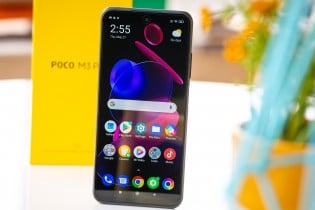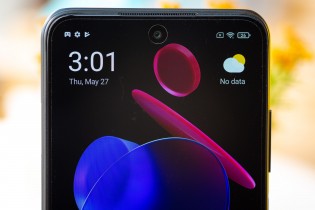With over 3 million units shipped, the Poco M3 is clearly a success. Now before us stands the Poco M3 Pro and it wants to convince us that we need more speed in our lives and that the €30 premium is worth it.
The vanilla M3 was equipped with a lovely display for the price segment, the Pro model adds 90Hz refresh rate to the mix. This new panel seems brighter too, so this could be one of the better parts of the phone.
A 6.5″ IPS LCD with 90 Hz refresh rate and Gorilla Glass 3 • Punch hole instead of a notch
The battery life on the vanilla model was stellar, our only complaint was that with charging limited to 18W it took three full hours for a 100% charge. The monkey paw has answered our wish – the Pro model will charge faster, but only because battery capacity dropped from 6,000 mAh to 5,000 mAh (charging is still limited to 18W). At least you get a charger in the box, a 22.5W one at that.
And it is still a pretty large battery, so it should take a long while to drain, though there are a couple of things to consider. First, the 90Hz display will draw more power. Second, the chipset is fabbed on a more recent node and should be more power efficient.
The M3 Pro is still capped at 18W charging • Card tray for 2 SIMs and 1 microSD
The Dimensity 700 is a 7nm chip, compared to the older 11 nm Snapdragon 662 inside the vanilla phone. We’ve already benchmarked the Dimensity (it is at the heart of the Realme 8 5G), so we know it has a much higher single-core CPU performance and the GPU compute power is practically doubled.
Not bad for €30 more, even if you don’t have access to a 5G network. Many already do, but the appeal of the fast, low-latency connection is parred down if you don’t do a lot of gaming or stream high quality video. And those are better experienced on a more premium device.
USB-C (2.0) • 3.5 mm headphone jack and IR blaster
The budget that went into the 5G modem could have bought an extra camera – the M3 Pro would have benefited from an ultrawide module. The main camera was pretty good, though getting capped 1080p 30 fps video was limiting. You’d think that the faster chipset would raise that to 4K, but no.
48 MP main camera (limited to 1080p @ 30 fps video), plus a macro cam and depth sensor
By the way, the Poco M3 Pro is based on the Redmi Note 10 5G. And when we say “based on”, we mean the two are almost exactly the same. The back is different, of course, and the card tray has a dedicated spot for a microSD (the Redmi has a hybrid slot). The price is different too – the Redmi-branded model sells for €230 with the same memory configuration, compared to €200 for the Poco model.
We have completed our review of the Redmi Note 10 5G and now we’re starting on the Poco M3 Pro one. We don’t expect them to be substantially different, but something might surprise us.








